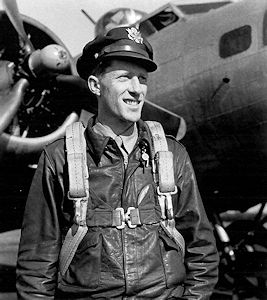Wes Sullivan B17 Pilot
35th & Final Mission

I'd gained my first pilot rating a few weeks earlier, but I elected to finish out my tour as co-pilot with the crew I'd joined back in Ardmore, Okla. (We still hold crew reunions every other year.) I was two missions behind the rest of the crew. To catch up, I volunteered for two missions while the rest of the crew went to London on a two-day pass.
The morning of March 18th, we were hoping for a milk run, on our final mission. We were deputy lead plane, which meant that our navigator, Gene Hackney, went to a special briefing before the general briefing. We got used to watching his facial expression as he came out of the briefing room for a clue as to how tough the mission would be. That morning his face was as glum as I'd ever seen it. We were going to "Big B."

In those final months of the war, the Mighty Eighth mounted over 1,000 B-17s on each raid. What a show that was. We took off in pitch dark and immediately began firing signal flares through the top of the plane. The color code on those flares indicated our group. We were the 385th Bomb Group, 548th Squadron. The sky over Eastern England was ablaze with those flares, the greatest pyrotechnic display ever seen. By the time we were at 16,000 feet, we'd sorted it all out and were assembled in our groups.
Then began the greatest aerial ballet ever, with those huge groups of 36 planes maneuvering into position at one minute intervals. On that March 18 morning, while we were bombing Berlin, planes still were assembling over Britain in a line across the channel and across Germany. Over 10,000 men in the air on one mission. There never will be another labor-intensive aerial war like that, never such a spectacular show. It is no wonder that people of later generations look back on that era with awe. Big B, along with the gasoline fabrication plants at Mersberg, were the most heavily defended targets in Germany. That morning was no exception. As we unloaded our bombs on the target, we came under heavy antiaircraft fire. Our lead plane was shot down, so we moved into the lead position.

Then it was our turn. The glass was blown out of the cockpit, #3 engine started spewing oil. A piece of shrapnel tore a jagged hole in our left aileron while we were in a turn, taking us out of formation and leaving us circling, alone, over Berlin. My first pilot, Bill Whitehead, began cranking in the big tail of the plane, to counter the effect of the aileron. That huge 19-foot tail was controlled by a tiny control cable. It would put an intolerable strain on that cord to force the tail into the wind. He applied the pressure slowly as we held our breath. Suddenly, Bill said to me over the intercom, his voice sounding like that of a whipped puppy, "The cable just gave way, Sully. We're going down."
I'll never forget that moment. I wouldn't get to go home to my wife Elsie, pregnant in Oregon with our first son. To have come this far, and not to make it. Just then I heard another voice, from amidships. It was Len Edwards, our waist gunner, saying, "I just hit my helmet on the rudder cable. I'm sorry." Suddenly, there was hope. Slowly, we brought the plane to a straight course, barely able to maintain flying speed, headed for home. We came all the way back to England, into the jet stream, at a ground speed of 85 miles per hour.
We weren't sure how the plane would behave on landing. We offered the crew the option of bailing out. No one accepted. We dragged the plane in over the end of the field at Great Ashfield. We were down. It was over. I could go home to my pregnant wife. Someone met me as I went back to the barracks telling me I'd been promoted to first lieutenant.
People may wonder why those of us who flew B-17s in the Eighth Air Force remain, to the end of our days, in love with that plane. It brought us back.
|